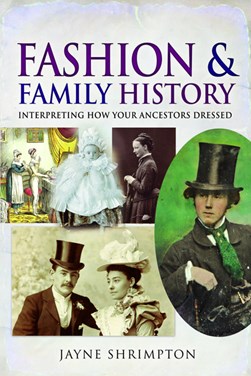-
BROWSE 1000s OF BOOKS IN STOCK
-
FREE DELIVERY ON ORDERS OVER €10
Fashion and family history
PAPERBACK
Categories:
Family history, tracing ancestors
Studying dress history teaches us much about the past. In this skilfully-illustrated, accessible and authoritative book, Jayne Shrimpton demonstrates how fashion and clothes represent the everyday experiences of earlier generations, illuminating the world in which they lived. As Britain evolved during the 1800s from a slow-paced agrarian society into an urban-industrial nation, dress was transformed. Traditional rural styles declined and modern city modes, new workwear and holiday gear developed. Women sewed at home, while shopping advanced, novel textiles and mass-produced goods bringing affordable fashion to ordinary people. Many of our predecessors worked as professional garment-makers, laundresses or in other related trades: close to fashion production, as consumers they looked after their clothes. The author explains how, understanding the social significance of dress, the Victorians observed strict etiquette through special costumes for Sundays, marriage and mourning. Poorer families struggled to maintain standards, but young single workers spent their wages on clothes, the older generation cultivating their own discreet style. Twentieth-century dress grew more relaxed and democratic as popular culture influenced fashion for recent generations who enjoyed sport, cinema, music and dancing.
€21.74

65 Reward Points
In stock online
Extended Range: Delivery in 2-3 working days
Extended Range: Delivery in 2-3 working days
Free Delivery on this item
Any purchases for more than €10 are eligible for free delivery anywhere in the UK or Ireland!
Studying dress history teaches us much about the past. In this skilfully-illustrated, accessible and authoritative book, Jayne Shrimpton demonstrates how fashion and clothes represent the everyday experiences of earlier generations, illuminating the world in which they lived. As Britain evolved during the 1800s from a slow-paced agrarian society into an urban-industrial nation, dress was transformed. Traditional rural styles declined and modern city modes, new workwear and holiday gear developed. Women sewed at home, while shopping advanced, novel textiles and mass-produced goods bringing affordable fashion to ordinary people. Many of our predecessors worked as professional garment-makers, laundresses or in other related trades: close to fashion production, as consumers they looked after their clothes. The author explains how, understanding the social significance of dress, the Victorians observed strict etiquette through special costumes for Sundays, marriage and mourning. Poorer families struggled to maintain standards, but young single workers spent their wages on clothes, the older generation cultivating their own discreet style. Twentieth-century dress grew more relaxed and democratic as popular culture influenced fashion for recent generations who enjoyed sport, cinema, music and dancing.

65 Reward Points
Any purchases for more than €10 are eligible for free delivery anywhere in the UK or Ireland!
€21.74

65 Reward Points
Any purchases for more than €10 are eligible for free delivery anywhere in the UK or Ireland!
Categories:
Family history, tracing ancestors
Product Description
Studying dress history teaches us much about the past. In this skilfully-illustrated, accessible and authoritative book, Jayne Shrimpton demonstrates how fashion and clothes represent the everyday experiences of earlier generations, illuminating the world in which they lived. As Britain evolved during the 1800s from a slow-paced agrarian society into an urban-industrial nation, dress was transformed. Traditional rural styles declined and modern city modes, new workwear and holiday gear developed. Women sewed at home, while shopping advanced, novel textiles and mass-produced goods bringing affordable fashion to ordinary people. Many of our predecessors worked as professional garment-makers, laundresses or in other related trades: close to fashion production, as consumers they looked after their clothes. The author explains how, understanding the social significance of dress, the Victorians observed strict etiquette through special costumes for Sundays, marriage and mourning. Poorer families struggled to maintain standards, but young single workers spent their wages on clothes, the older generation cultivating their own discreet style. Twentieth-century dress grew more relaxed and democratic as popular culture influenced fashion for recent generations who enjoyed sport, cinema, music and dancing.
Product Details
ISBN9781526760265
FormatPAPERBACK
PublisherPEN & SWORD FAMILY HISTORY (30 November. 2020)
No. of Pages160
Weight468
Language English
Dimensions 234 x 156 x 22

